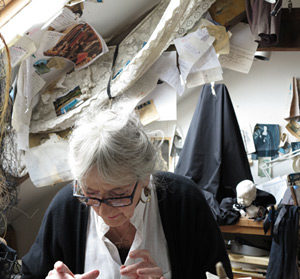Wales Arts Review shares a short memoriam of the multi-media artist Rozanne Hawksley who passed away at the very start of this year.
Rozanne Hawksley, an artistic innovator who worked with textiles and embroidery, has died aged 91. Her work was known for its defiance of genre, ranging broadly from the small and exquisitely detailed to the broad and physical. As an artist, Hawksley was often preoccupied with the human condition – in particular with death and human suffering – and much of her work took inspiration from the tensions between power and vulnerability, making use of tender and delicate materials to emotively capture abuses of power, oppression and the human suffering accumulated as a consequence.
Hawksley was born in the maritime port of Portsmouth in 1931, and later drew much inspiration from her experience as both an evacuee during the war and the mourning for those who didn’t return in its aftermath (a future piece, ‘The Seamstress and the Sea’, would form a part of the Imperial War Museum’s first art installation aboard the HMS Belfast). Hawskley received her training in fashion from the Royal College of Art during the early 1950s, and would go on to work in various colleges bringing her into contact with the work of Jean Muir and Yves Saint-Laurent as well as a number of couture boutiques. After returning from a stint in America, Hawksley began a postgraduate course at Goldsmiths College in the ‘70s. It was here, under the mentorship of David Green, that she both uncovered and solidified a talent for textile and stitching used as a form of artistic expression.
As Hawksley later told Embroidery Magazine: “I regard very strongly that stitch and fabric is one of the media that is a means to express whatever we want to say. Stitch is incredible and beautiful on its own – as a painting or engraving is – but I don’t think we should see it as something separate.”
“I am uneasy about the division of what is craft and art. There are superb craftsmen, and it is not to say their work is any lower than whatever fine art means. I think perhaps the difference is that maybe the person who calls [themselves] an artist is using a craft plus a great deal of thinking in an abstract way – that there is something going on in the heart and mind that they need to externalise.”
From her time at Goldsmiths, Hawksley went on to forge a formidable artistic career working in a mixed-media format to produce works of profound influence and emotion. It was her inclusion in the pioneering ‘Subversive Stitch’ exhibition in the ‘80s which really propelled her work forward, attracting the attention of many critics and bringing her work to cities across Britain and Europe. Hawksley moved to west Wales with her family in the late ‘80s, and continued to produce work from there, with her first solo exhibition, ‘Textile’, opening at the age of 78.
From ‘Pale Armistice’ to ‘A Treaty will Shortly be Signed…’ and memorial pieces including one for Aberfan, Hawksley was – as she was often described – “one of the UK’s great embroidery innovators”.












